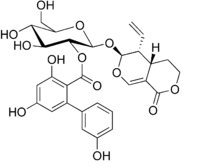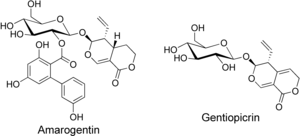This is an old revision of this page, as edited by Beetstra (talk | contribs) at 14:29, 21 October 2011 (Script assisted update of identifiers for the Chem/Drugbox validation project (updated: 'ChEMBL', 'CASNo').). The present address (URL) is a permanent link to this revision, which may differ significantly from the current revision.
Revision as of 14:29, 21 October 2011 by Beetstra (talk | contribs) (Script assisted update of identifiers for the Chem/Drugbox validation project (updated: 'ChEMBL', 'CASNo').)(diff) ← Previous revision | Latest revision (diff) | Newer revision → (diff)
| |
| Names | |
|---|---|
| IUPAC name pyran-3-yl]oxy]-4,5-dihydroxy-6-(hydroxymethyl)oxan-3-yl]2,4-dihydroxy-6-(3-ydroxyphenyl)benzoate | |
| Identifiers | |
| 3D model (JSmol) | |
| ChEBI | |
| ChEMBL | |
| ChemSpider | |
| ECHA InfoCard | 100.166.688 |
| PubChem CID | |
| CompTox Dashboard (EPA) | |
InChI
| |
SMILES
| |
| Properties | |
| Chemical formula | C29H30O13 |
| Molar mass | 586.54 g/mol |
| Except where otherwise noted, data are given for materials in their standard state (at 25 °C , 100 kPa).
| |
Amarogentin is a chemical compound found in gentian (Gentiana lutea) or in Swertia chirata.

Gentian root has a long history of use as a herbal bitter in the treatment of digestive disorders and is an ingredient of many proprietary medicines. The bitter principles of gentian root are seco-iridoid glycosides amarogentin and gentiopicrin. The former is one of the most bitter natural compounds known and is used as a scientific basis for measuring bitterness. In humans, it activates the bitter taste receptor hTAS2R50. The biphenylcarboxylic acid moiety is biosynthesized by a polyketide-type pathway, with three units of acetyl-CoA and one unit of 3-hydroxybenzoyl-CoA, this being formed from an early shikimate pathway intermediate and not via cinnamic or benzoic acid.
It also shows an antileishmanial activity being an inhibitor of topoisomerase I.
References
- Production of amarogentin in root cultures of Swertia chirata. Keil M, Härtle B, Guillaume A and Psiorz M, Planta Med. 2000 Jun;66(5), pages 452-457, PMID 10909267, doi:10.1055/s-2000-8579
- Heilpflanzen:Gentiana lutea (German)
- The human bitter taste receptor hTAS2R50 is activated by the two natural bitter terpenoids andrographolide and amarogentin. Behrens M, Brockhoff A, Batram C, Kuhn C, Appendino G and Meyerhof W, J Agric Food Chem. 2009 Nov 11, 57(21), pages 9860-9866, doi:10.1021/jf9014334
- Unexpected Biosynthetic Precursors of Amarogentin − A Retrobiosynthetic C NMR Study. Chang-Zeng Wang, Ulrich H. Maier, Wolfgang Eisenreich, Petra Adam, Ingrid Obersteiner, Michael Keil, Adelbert Bacher and Meinhart H. Zenk, European Journal of Organic Chemistry, Volume 2001, Issue 8, pages 1459–1465, April 2001, doi:10.1002/1099-0690(200104)2001:8<1459::AID-EJOC1459>3.0.CO;2-0
- Evaluation of the in-vivo activity and toxicity of amarogentin, an antileishmanial agent, in both liposomal and niosomal forms. Swapna Medda, Sibabrata Mukhopadhyay and Mukul Kumar Basu, J. Antimicrob. Chemother., (1999) 44 (6), pages 791-794, doi:10.1093/jac/44.6.791
- Amarogentin, a Naturally Occurring Secoiridoid Glycoside and a Newly Recognized Inhibitor of Topoisomerase I from Leishmania donovani. Sutapa Ray, Hemanta K. Majumder, Ajit K. Chakravarty, and Sibabrata Mukhopadhyay, J. Nat. Prod., 1996, 59 (1), pages 27–29, doi:10.1021/np960018g